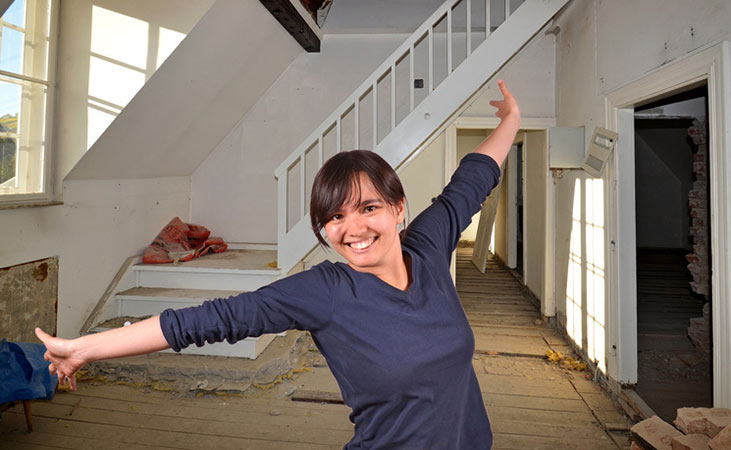In Germany and Austria, the renovation of old buildings currently accounts for half of the annual construction volume. The reason for this is usually the high cost of heating and maintenance. However, refurbishment is not always refurbishment. In this article, you’ll learn 5 things you should definitely consider when renovating an old building in relation to your heating system.
#1 Not every heating system is suitable for every heating need
Not every heating system is optimally suited to cover a high or low heat demand.
Example: Electric heaters
They are low in initial cost but high in consumption cost. If the electric heater draws its energy exclusively from the grid, it can be expensive for you. Unless you only heat your home for a short time during the year.
Example: Combined heat and power plants (in short: CHPs)
The situation is the other way around for CHP units. These are particularly suitable when there is a high demand for heat throughout the year. The high initial cost is offset by the savings in energy costs.
The heating system is popular for use in large facilities, such as hotels. CHP units are usually unattractive for single-family homes.
As an alternative solution, so-called mini or nano CHP units have been developed for this purpose, but these are also only profitable if the house is heated all year round.
#2 Heat pumps work most efficiently in low-temperature systems
The Federal Statistical Office reveals that in 2016, a heat pump was installed in about 32 percent of approved residential buildings. Likewise, it is high in the race for old building renovations.
Due to the low cost of heating and the use of renewable energy, the heating source is becoming more popular every year. However, caution is called for. After all, the pump only saves costs if it works efficiently. And it does that when the system temperature is low.
At high system temperatures, the opposite happens – unnecessarily high heating costs are incurred.
Heat pumps are suitable in combination with surface heating systems
How high the system temperature is depends on the distribution system. For example, heat pumps are particularly well suited for surface heating systems. Here the supply and return temperature is very low.
Radiators, on the other hand, often operate at very high temperatures and are therefore only of limited use in conjunction with a heat pump.
In old building renovations, owners like to resort to the popular heat pump, if a surface heating system is feasible or already available. There are now some distribution systems on the market that can be retrofitted – even in listed buildings.
#3 The EnEV prescribes: You have to throw out your old boiler!
Not only are you recommended to replace your old boiler, but it is actually mandatory. Do you have a boiler in the basement that was installed before October 1978? The EnEV stipulates that you must replace it with a new one. The renovation of old buildings is a good opportunity to fulfill this obligation.
Benefit for the environment and your wallet
Even if your boiler was installed in the 1990s, it makes sense to consider replacing it. Since then, heating technology and regenerative energies have developed greatly.
Early replacement can mean environmental and economic benefits for you.
#4 Less heat loss due to good insulation
If you’re renovating your heating system, it also makes sense to rethink your insulation. Although heat can be created inexpensively through advanced heating technology, it is pointless if it then immediately disappears back outside.
Good insulation is especially noticeable in convection heating systems, as they operate via convection heat. With panel heating, insulation plays only a very small role because the air is cooler in this case.
Thermal insulation windows lead to a tighter building
A window replacement is associated with higher investment costs, but can save you a lot of energy costs. The prerequisite for this is professional installation.
The disadvantage associated with tight windows is the humidity trapped in the building. In this case, you need to pay special attention to ventilate properly. Otherwise, the new windows would cause mold to form.
Decreasing heat loss due to insulation of the facade
Facade insulation can also reduce heat loss. There are several types of insulation, and when installing them must always comply with minimum legal requirements.
When deciding on the best insulation materials, you should consult a specialist company. The experts can give you qualified advice.
#5 Renewable energies are environmentally friendly and save costs
Of concern is that fuel costs are expected to rise even further and resources are finite. This is a reason for many building owners to switch to hybrid heating systems.
Hybrid heaters are environmentally friendly and safe
This type of heating is not a separate heating system. Rather, it is a combination of several heating systems. For example, a conventional gas heating system can work together with a solar thermal system.
As long as the renewable energies are available, they will be used for heat generation. If these are not available, the safe heating operation of the gas heating system intervenes.
Hybrid heaters come in a wide variety of combinations. These can be used in both old and new buildings.
Conclusion: Renovation pays off if you do it right!
Old buildings are very popular because of their charm. However, if it turns out that heating causes high costs or health suffers, it may become inconvenient. The way out is the renovation of old buildings.
The good news is there are many ways to live more energy efficient and healthier. You just need to research well and follow the above 5 points. Good luck with it!
Our panel heating works particularly energy-saving and can be optimally retrofitted in old building renovations. If you also want to benefit from energy-saving panel heating, click here.
Yes, I would like to benefit from energy-saving panel heating.
Photo: photo 5000 – fotolia.com



 Wir sind Annette & Christian Egger. Hier im Blog erklären wir Ihnen, worauf es beim Wohlfühl-Klima ankommt. Wir behandeln hier Themen wie Energie-Sparen beim Heizen & Kühlen und zeigen Ihnen unsere interessantesten Projekte.
Wir sind Annette & Christian Egger. Hier im Blog erklären wir Ihnen, worauf es beim Wohlfühl-Klima ankommt. Wir behandeln hier Themen wie Energie-Sparen beim Heizen & Kühlen und zeigen Ihnen unsere interessantesten Projekte. 